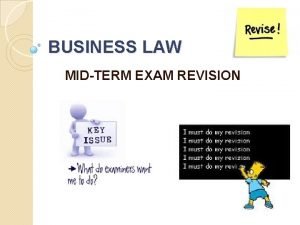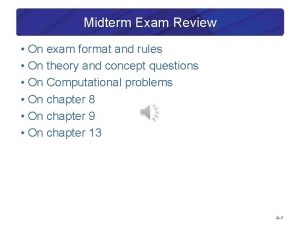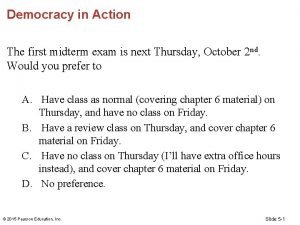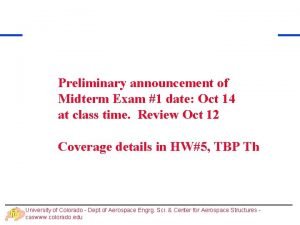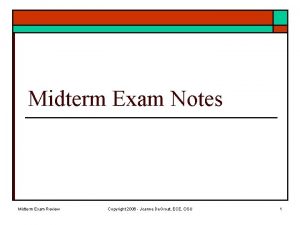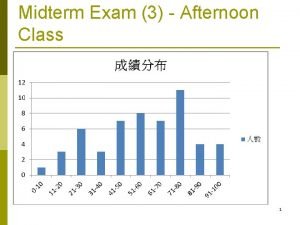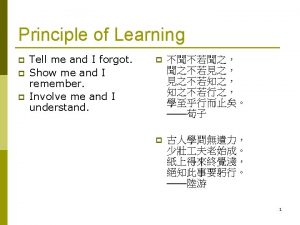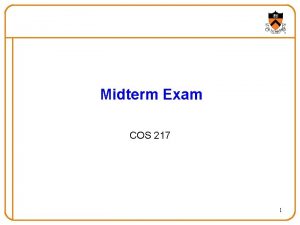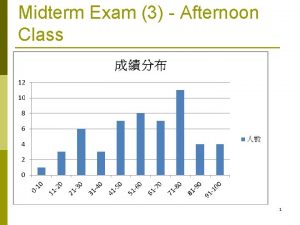Democracy in Action The first midterm exam is











































- Slides: 43

Democracy in Action The first midterm exam is next Thursday, October 2 nd. Would you prefer to A. Have class as normal (covering chapter 6 material) on Thursday, and have no class on Friday. B. Have a review class on Thursday, and cover chapter 6 material on Friday. C. Have no class on Thursday (I’ll have extra office hours instead), and cover chapter 6 material on Friday. D. No preference. © 2015 Pearson Education, Inc. Slide 5 -1

Section 5. 2 Dynamics and Newton’s Second Law (cont. ) © 2015 Pearson Education, Inc.

Quick. Check 5. 2 The box is sitting on the floor of an elevator. The elevator is accelerating upward. The magnitude n of the normal force on the box is (w is the weight) A. B. C. D. E. n>w n=w n<w n=0 Not enough information to tell © 2015 Pearson Education, Inc. Slide 5 -3

Quick. Check 5. 2 The box is sitting on the floor of an elevator. The elevator is accelerating upward. The magnitude n of the normal force on the box is (w is the weight) A. B. C. D. E. Upward acceleration requires a net upward force. n>w n=w n<w n=0 Not enough information to tell © 2015 Pearson Education, Inc. Slide 5 -4

Example 5. 6 Towing a car with acceleration A car with a mass of 1500 kg is being towed by a rope held at a 20° angle to the horizontal. A friction force of 320 N opposes the car’s motion. What is the tension in the rope if the car goes from rest to 12 m/s in 10 s? © 2015 Pearson Education, Inc. Slide 5 -5

Example 5. 6 Towing a car with acceleration (cont. ) You should recognize that this problem is almost identical to Example 5. 4. The difference is that the car is now accelerating, so it is no longer in equilibrium. This means, as shown in FIGURE 5. 7, that the net force is not zero. We’ve already identified all the forces in Example 5. 4. PREPARE © 2015 Pearson Education, Inc. Slide 5 -6

Example 5. 6 Towing a car with acceleration (cont. ) © 2015 Pearson Education, Inc. Slide 5 -7

Example 5. 6 Towing a car with acceleration (cont. ) SOLVE Newton’s second law in component form is Fx = nx + Tx + fx + wx = max Fy = ny + Ty + fy + wy = may = 0 We’ve again used the fact that ay = 0 for motion that is purely along the x-axis. The components of the forces were worked out in Example 5. 4. With that information, Newton’s second law in component form is T cos f = max n + T sin w = 0 © 2015 Pearson Education, Inc. Slide 5 -8

Example 5. 6 Towing a car with acceleration (cont. ) Because the car speeds up from rest to 12 m/s in 10 s, we can use kinematics to find the acceleration: © 2015 Pearson Education, Inc. Slide 5 -9

Example 5. 6 Towing a car with acceleration (cont. ) We can now use the first Newton’s-law equation above to solve for the tension. We have The tension is substantially greater than the 340 N found in Example 5. 4. It takes much more force to accelerate the car than to keep it rolling at a constant speed. ASSESS © 2015 Pearson Education, Inc. Slide 5 -10

Section 5. 3 Mass and Weight © 2015 Pearson Education, Inc.

Mass and Weight • Mass and weight are not the same thing. • Mass is a quantity that describes an object’s inertia, its tendency to resist being accelerated. • Weight is the gravitational force exerted on an object by a planet – near a planet’s surface we have w = mg where g is the acceleration due to gravity on that planet – on Earth g = 9. 8 m/s 2 © 2015 Pearson Education, Inc. Slide 5 -12

Mass and Weight © 2015 Pearson Education, Inc. Slide 5 -13

Example 5. 7 Typical masses and weights What are the weight, in N, and the mass, in kg, of a 90 pound gymnast, a 150 pound professor, and a 240 pound football player? © 2015 Pearson Education, Inc. Slide 5 -14

Example 5. 7 Typical masses and weights (cont. ) We can use the conversions and correspondences in Table 5. 1. PREPARE We will use the correspondence between mass and weight just as we use the conversion factor between different forces: SOLVE © 2015 Pearson Education, Inc. Slide 5 -15

Apparent Weight • The weight of an object is the force of gravity on that object. • Your sensation of weight is due to contact forces supporting you. • Let’s define your apparent weight wapp in terms of the force you feel: © 2015 Pearson Education, Inc. Slide 5 -16

Apparent Weight • The only forces acting on the man are the upward normal force of the floor and the downward weight force: n = w + ma wapp = w + ma • Thus wapp > w and the man feels heavier than normal. © 2015 Pearson Education, Inc. Slide 5 -17

Example 5. 8 Apparent weight in an elevator Anjay’s mass is 70 kg. He is standing on a scale in an elevator that is moving at 5. 0 m/s. As the elevator stops, the scale reads 750 N. Before it stopped, was the elevator moving up or down? How long did the elevator take to come to rest? © 2015 Pearson Education, Inc. Slide 5 -18

Example 5. 8 Apparent weight in an elevator Anjay’s mass is 70 kg. He is standing on a scale in an elevator that is moving at 5. 0 m/s. As the elevator stops, the scale reads 750 N. Before it stopped, was the elevator moving up or down? How long did the elevator take to come to rest? PREPARE The scale reading (750 N) is Anjay’s apparent weight. Anjay’s actual weight is w = mg = (70 kg)(9. 80 m/s 2) = 686 N © 2015 Pearson Education, Inc. Slide 5 -19

Example 5. 8 Apparent weight in an elevator (cont. ) SOLVE The vertical component of Newton’s second law is Fy = n w = may n is the normal force, which is the scale force on Anjay, 750 N. w is his weight, 686 N. We can thus solve for ay: To find the stopping time, we can use (vy)f = (vy)i + ay Δt (vy)i = 5. 0 m/s, and (vy)f = 0. so the time interval is 5. 5 s. © 2015 Pearson Education, Inc. Slide 5 -20

Example 5. 8 Apparent weight in an elevator (cont. ) ASSESS Think about riding elevators. If the elevator is moving downward and then comes to rest, you “feel heavy. ” This gives us confidence that our analysis of the motion is correct. 5. 0 m/s is fast - the elevator will be passing more than one floor per second. If you’ve been in a fast elevator in a tall building, you know that 5. 5 s is reasonable for the time it takes for the elevator to slow to a stop. © 2015 Pearson Education, Inc. Slide 5 -21

Weightlessness • A person in free fall has zero apparent weight. • “Weightless” does not mean “no weight. ” • An object that is weightless has no apparent weight. © 2015 Pearson Education, Inc. Slide 5 -22

Quick. Check 5. 5 A 50 -kg student (mg = 490 N) gets in a 1000 -kg elevator at rest and stands on a metric bathroom scale. As the elevator accelerates upward, the scale reads A. B. C. D. > 490 N < 490 N but not 0 N 0 N © 2015 Pearson Education, Inc. Slide 5 -23

Quick. Check 5. 5 A 50 -kg student (mg = 490 N) gets in a 1000 -kg elevator at rest and stands on a metric bathroom scale. As the elevator accelerates upward, the scale reads A. B. C. D. > 490 N < 490 N but not 0 N 0 N © 2015 Pearson Education, Inc. Slide 5 -24

Quick. Check 5. 6 A 50 -kg student (mg = 490 N) gets in a 1000 -kg elevator at rest and stands on a metric bathroom scale. Sadly, the elevator cable breaks. What is the reading on the scale during the few seconds it takes the student to plunge to his doom? A. B. C. D. > 490 N < 490 N but not 0 N 0 N © 2015 Pearson Education, Inc. Slide 5 -25

Quick. Check 5. 6 A 50 -kg student (mg = 490 N) gets in a 1000 -kg elevator at rest and stands on a metric bathroom scale. Sadly, the elevator cable breaks. What is the reading on the scale during the few seconds it takes the student to plunge to his doom? A. B. C. D. > 490 N < 490 N but not 0 N The bathroom scale would read 0 N. Weight is reading of a scale on which the object is stationary relative to the scale. © 2015 Pearson Education, Inc. Slide 5 -26

Section 5. 4 Normal Forces © 2015 Pearson Education, Inc.

Normal Forces • An object at rest on a table is subject to an upward force due to the table. • This force is called the normal force because it is always directed normal, or perpendicular, to the surface of contact. • The normal force adjusts itself so that the object stays on the surface without penetrating it. © 2015 Pearson Education, Inc. Slide 5 -28

Example 5. 9 Normal force on a pressed book A 1. 2 kg book lies on a table. The book is pressed down from above with a force of 15 N. What is the normal force acting on the book from the table below? © 2015 Pearson Education, Inc. Slide 5 -29

Example 5. 9 Normal force on a pressed book A 1. 2 kg book lies on a table. The book is pressed down from above with a force of 15 N. What is the normal force acting on the book from the table below? The book is not moving and is thus in static equilibrium. PREPARE © 2015 Pearson Education, Inc. Slide 5 -30

Example 5. 9 Normal force on a pressed book (cont. ) This is a statics problem, so net force is zero. All forces act in the y-direction – using Newton’s second law SOLVE Fy = ny + wy + Fy = n w F = may = 0 The weight of the book is w = mg = (1. 2 kg)(9. 8 m/s 2) = 12 N Hence, the normal force exerted by the table is n = F + w = 15 N + 12 N = 27 N © 2015 Pearson Education, Inc. Slide 5 -31

Example 5. 9 Normal force on a pressed book (cont. ) The normal force is larger than the weight of the book. Why? ASSESS The extra force from the hand pushes the book further into the atomic “springs” of the table. These “springs” then push back harder, giving a normal force that is strong enough to fight back against both the weight and the force of the hand. © 2015 Pearson Education, Inc. Slide 5 -32

Normal Forces © 2015 Pearson Education, Inc. Slide 5 -33

Normal Forces © 2015 Pearson Education, Inc. Slide 5 -34

Quick. Check 5. 4 What are the components of shown? © 2015 Pearson Education, Inc. in the coordinate system Slide 5 -35

Quick. Check 5. 4 What are the components of shown? in the coordinate system D © 2015 Pearson Education, Inc. Slide 5 -36

Quick. Check 5. 3 A box is being pulled to the right at steady speed by a rope that angles upward. In this situation: A. B. C. D. E. n > mg n = mg n < mg n=0 Not enough information to judge the size of the normal force © 2015 Pearson Education, Inc. Slide 5 -37

Quick. Check 5. 3 A box is being pulled to the right at steady speed by a rope that angles upward. In this situation: A. B. C. D. E. n > mg n = mg n < mg n=0 Not enough information to judge the size of the normal force © 2015 Pearson Education, Inc. Slide 5 -38

Example 5. 10 Acceleration of a downhill skier A skier slides down a steep 27° slope. On a slope this steep, friction is much smaller than the other forces at work and can be ignored. What is the skier’s acceleration? © 2015 Pearson Education, Inc. Slide 5 -39

Example 5. 10 Acceleration of a downhill skier (cont. ) We choose a coordinate system tilted so that the x-axis points down the slope - this greatly simplifies the analysis. PREPARE © 2015 Pearson Education, Inc. Slide 5 -40

Example 5. 10 Acceleration of a downhill skier (cont. ) We can use Newton’s second law to find the skier’s acceleration: SOLVE Fx = wx + nx = max Fy = wy + ny = may Because points directly in the positive y-direction, ny = n and nx = 0. The components of are wx = w sin = mg sin and wy = w cos = mg cos , (where = 27˚, and w = mg). Hence Fx = wx + nx = mx sin = max Fy = wy + ny = mg cos + n = may = 0 © 2015 Pearson Education, Inc. Slide 5 -41

Example 5. 10 Acceleration of a downhill skier (cont. ) In the second equation we used the fact that ay = 0. The m cancels in the first of these equations, leaving us with ax = g sin (Remember this from Chapter 3 – now you see where it comes from). The skier’s acceleration is then ax = g sin = (9. 8 m/s 2) sin 27° = 4. 4 m/s 2 © 2015 Pearson Education, Inc. Slide 5 -42

Example 5. 10 Acceleration of a downhill skier (cont. ) ASSESS Let’s check some special cases. • When = 0, so that the slope is horizontal, the skier’s acceleration is zero, as it should be. • When = 90° (a vertical slope), his acceleration is g, which makes sense because he’s in free fall when = 90°. © 2015 Pearson Education, Inc. Slide 5 -43
 Different between parliamentary and presidential
Different between parliamentary and presidential Nlp midterm exam
Nlp midterm exam Data mining exam
Data mining exam Features of html
Features of html College english midterm exam
College english midterm exam Business law midterm exam
Business law midterm exam Midterm exam for applied research methods
Midterm exam for applied research methods English 9 midterm exam
English 9 midterm exam Introduction to computer science midterm exam
Introduction to computer science midterm exam Introduction to computer science midterm exam test
Introduction to computer science midterm exam test Ap english language and composition midterm exam
Ap english language and composition midterm exam Algebra 2 midterm study guide
Algebra 2 midterm study guide Grva midterm exam
Grva midterm exam Midterm exam format
Midterm exam format American literature midterm exam
American literature midterm exam World history semester exam
World history semester exam English 11 midterm exam
English 11 midterm exam Database systems midterm exam
Database systems midterm exam Apes midterm practice test
Apes midterm practice test What is a midterm
What is a midterm Geometry midterm exam review
Geometry midterm exam review Exam midterm
Exam midterm Ap chemistry midterm exam
Ap chemistry midterm exam Algebra 1 midterm exam
Algebra 1 midterm exam Midterm exam announcement
Midterm exam announcement Homework app
Homework app Operating systems midterm
Operating systems midterm Xiao comp
Xiao comp Hình ảnh bộ gõ cơ thể búng tay
Hình ảnh bộ gõ cơ thể búng tay Slidetodoc
Slidetodoc Bổ thể
Bổ thể Tỉ lệ cơ thể trẻ em
Tỉ lệ cơ thể trẻ em Chó sói
Chó sói Thang điểm glasgow
Thang điểm glasgow Hát lên người ơi alleluia
Hát lên người ơi alleluia Kể tên các môn thể thao
Kể tên các môn thể thao Thế nào là hệ số cao nhất
Thế nào là hệ số cao nhất Các châu lục và đại dương trên thế giới
Các châu lục và đại dương trên thế giới Công thức tính độ biến thiên đông lượng
Công thức tính độ biến thiên đông lượng Trời xanh đây là của chúng ta thể thơ
Trời xanh đây là của chúng ta thể thơ Mật thư tọa độ 5x5
Mật thư tọa độ 5x5 Làm thế nào để 102-1=99
Làm thế nào để 102-1=99 Phản ứng thế ankan
Phản ứng thế ankan Các châu lục và đại dương trên thế giới
Các châu lục và đại dương trên thế giới





